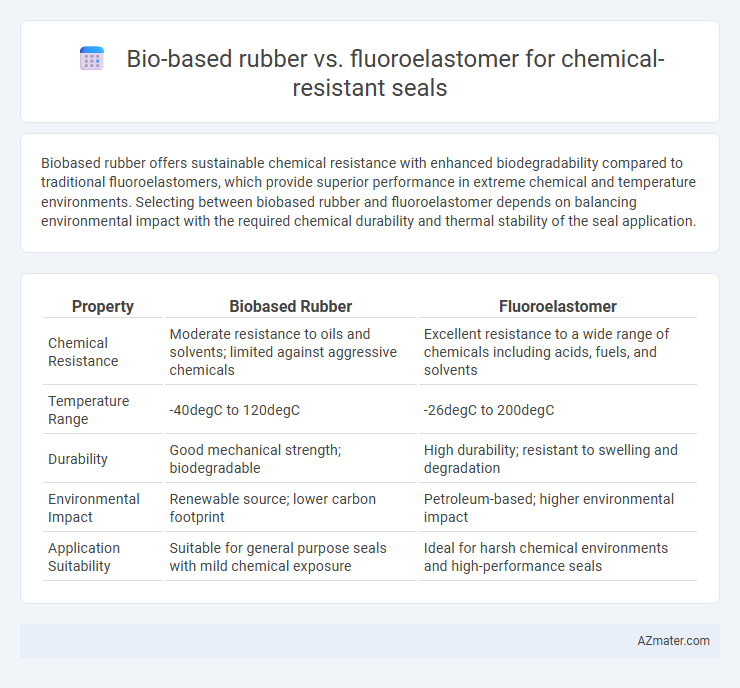Biobased rubber offers sustainable chemical resistance with enhanced biodegradability compared to traditional fluoroelastomers, which provide superior performance in extreme chemical and temperature environments. Selecting between biobased rubber and fluoroelastomer depends on balancing environmental impact with the required chemical durability and thermal stability of the seal application.
Table of Comparison
| Property | Biobased Rubber | Fluoroelastomer |
|---|---|---|
| Chemical Resistance | Moderate resistance to oils and solvents; limited against aggressive chemicals | Excellent resistance to a wide range of chemicals including acids, fuels, and solvents |
| Temperature Range | -40degC to 120degC | -26degC to 200degC |
| Durability | Good mechanical strength; biodegradable | High durability; resistant to swelling and degradation |
| Environmental Impact | Renewable source; lower carbon footprint | Petroleum-based; higher environmental impact |
| Application Suitability | Suitable for general purpose seals with mild chemical exposure | Ideal for harsh chemical environments and high-performance seals |
Introduction to Chemical Resistant Seals
Chemical resistant seals are crucial components in industrial applications requiring durable performance against aggressive chemicals. Biobased rubber offers eco-friendly benefits with moderate resistance to acids and solvents, making it suitable for less harsh environments. Fluoroelastomers provide superior chemical resistance, exceptional thermal stability, and long-lasting durability, ideal for sealing systems exposed to highly aggressive chemicals and extreme temperatures.
Overview of Biobased Rubber Materials
Biobased rubber materials, derived from renewable resources such as natural latex and plant oils, offer sustainable alternatives to traditional petrochemical-based elastomers for chemical-resistant seals. These materials exhibit excellent flexibility, resilience, and resistance to oils, solvents, and mild acids, making them suitable for various industrial sealing applications. Innovations in biopolymer blending and crosslinking technologies enhance their chemical stability and durability, positioning biobased rubber as a competitive option compared to fluoroelastomers in eco-friendly sealing solutions.
Properties and Performance of Fluoroelastomers
Fluoroelastomers exhibit exceptional chemical resistance, maintaining stability in aggressive environments with fuels, oils, acids, and solvents, outperforming biobased rubber alternatives in durability and thermal stability. Their molecular structure provides resistance to swelling, degradation, and hardening, ensuring long-lasting seal integrity under high temperatures up to 200-250degC. These properties make fluoroelastomers ideal for demanding sealing applications in automotive, aerospace, and chemical processing industries where reliability and performance are critical.
Chemical Resistance Comparison: Biobased Rubber vs Fluoroelastomer
Fluoroelastomers exhibit superior chemical resistance compared to biobased rubbers, maintaining performance in aggressive environments containing fuels, oils, and solvents. Biobased rubber, typically derived from natural or renewable sources, tends to degrade faster when exposed to strong acids, bases, or hydrocarbons. Fluoroelastomer seals deliver enhanced durability and longevity in harsh chemical applications, making them preferable for demanding industrial sealing solutions.
Mechanical Properties and Durability
Biobased rubber offers excellent elasticity and flexibility with moderate tensile strength, making it suitable for general-purpose chemical-resistant seals, but it typically exhibits lower abrasion resistance compared to fluoroelastomers. Fluoroelastomers demonstrate superior mechanical properties, including high tensile strength, exceptional resistance to compression set, and outstanding durability under extreme temperatures and aggressive chemical environments. The enhanced chemical resistance and long-term durability of fluoroelastomers make them the preferred choice for seals exposed to harsh chemicals and demanding industrial applications.
Environmental Impact and Sustainability
Biobased rubber offers a renewable alternative derived from natural sources, significantly reducing reliance on petroleum and lowering carbon emissions in chemical resistant seals. Fluoroelastomers, while highly effective in chemical resistance and durability, are petroleum-based and pose challenges in biodegradability and environmental persistence. Sustainable seal solutions increasingly favor biobased rubbers for their reduced ecological footprint and potential for circular economy integration in industrial applications.
Cost Analysis and Market Trends
Biobased rubber offers a cost-effective and sustainable alternative to fluoroelastomers in chemical-resistant seals, with production costs approximately 20-30% lower due to renewable raw materials and simpler processing. Fluoroelastomers maintain a premium market position driven by superior chemical resistance and high-temperature performance, commanding price premiums despite fluctuating supply chain costs linked to fluoropolymer raw materials. Market trends indicate increasing adoption of biobased rubber in eco-conscious sectors, while fluoroelastomers dominate high-performance applications, projecting steady growth fueled by stringent industrial safety standards and expanding end-use industries.
Application Suitability in Chemical Industries
Biobased rubber offers excellent flexibility and environmental benefits but may have limited resistance to aggressive chemicals compared to fluoroelastomers, which provide superior chemical stability and temperature resistance in harsh industrial environments. Fluoroelastomers are preferred in chemical processing, pharmaceutical, and petrochemical industries due to their ability to withstand strong acids, bases, and solvents without degradation. Application suitability for chemical-resistant seals favors fluoroelastomers when exposure to highly corrosive media and extreme operating conditions is expected, while biobased rubber seals are suitable for less aggressive environments and sustainability-focused applications.
Regulatory and Safety Considerations
Biobased rubber offers a sustainable alternative with lower environmental impact and fewer toxic byproducts compared to fluoroelastomers, aligning better with emerging regulatory frameworks aimed at reducing hazardous substances. Fluoroelastomers, although highly chemical resistant, often contain perfluorinated compounds subject to strict regulations such as REACH and EPA's PFAS restrictions due to their persistent bioaccumulative toxicity. Safety considerations prioritize biobased rubber in applications requiring compliance with green chemistry principles and reduced occupational exposure to harmful fluorinated compounds.
Future Prospects and Innovations in Seal Technology
Biobased rubber offers promising environmental benefits with enhanced biodegradability and renewable sourcing, driving innovation toward sustainable chemical-resistant seals. Fluoroelastomers maintain superior chemical resistance and high-temperature stability, prompting ongoing research into improving their recyclability and reducing environmental impact. Future seal technology developments focus on hybrid materials and advanced polymer blends to optimize performance, durability, and eco-friendly characteristics in demanding chemical applications.

Infographic: Biobased rubber vs Fluoroelastomer for Chemical resistant seal
 azmater.com
azmater.com